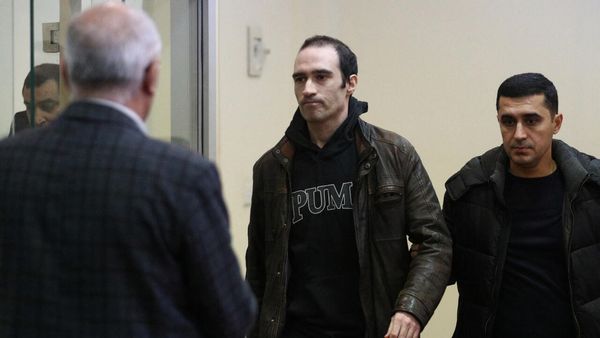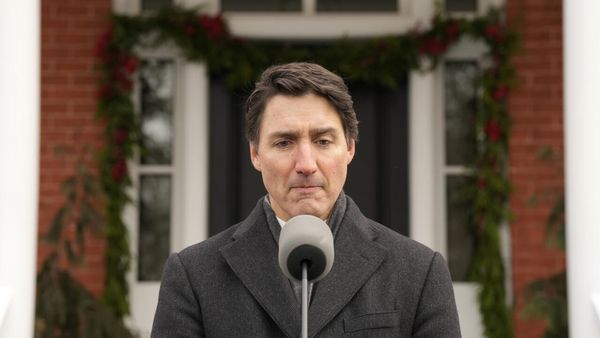
In the 1990s, alternative music was generally defined by the Seattle sound of acts like Nirvana, Pearl Jam, Alice in Chains and Soundgarden.
But the Chicago scene was different, with artists like Material Issue and Urge Overkill adding melody and the influence of power pop to an otherwise angsty space.
Urge Overkill in particular stood out, placing a premium upon style in a decade where flannel was the norm, dressing in matching suits with medallions bearing their logo (and tongue planted firmly in cheek).
But it was never style over substance. The group put forth catchier and catchier songs as they traversed their first four studio albums, working with producers like Steve Albini, Butch Vig and Butcher Bros.
Vocalists and guitarists Nash Kato and Eddie “King” Roeser both grew up in Minnesota, ultimately meeting and forming the band in Chicago while at Northwestern University. Kato grew up loving funk, “blissfully ignorant,” says Roeser, of the classic rock he’d grown tired of.
Kato’s intro to rock came in Chicago courtesy of Albini and Northwestern roommate Lyle Preslar, who’d played guitar in the seminal D.C. hardcore punk band Minor Threat.
Setting the tone for the straight edge, DIY punk rock that would follow, on paper, Minor Threat’s mission would seem to fly directly in the face of Urge Overkill’s, who’d go on to embrace moderate flamboyance and stereotypical rock excess as they chased success. Kato recalls a humorous early exchange with Preslar.
“I knew I wanted to be in a band when I went to college,” he said looking back. “Lyle and I originally were going to start a band. He was in Minor Threat and they broke up because he went to NU. But we were going to start this band and it ended when I asked him, ‘Hey, what are we gonna wear?’ And he was like, ‘What the f—k are you talking about?’ I went, ‘Well, you know, we have to wear something on stage...’ I was thinking suits - because of the whole funk thing. (Laughing) And then he transferred and I hooked up with Eddie and we started [Urge Overkill].”
A tour opening for Nirvana as Nevermind hit was followed by a slot on Pearl Jam’s Vs. tour and their cover of Neil Diamond’s “Girl, You’ll Be a Woman Soon” ultimately drove the Pulp Fiction soundtrack to sales of nearly 9 million worldwide.
The group’s latest album Oui (now available via Omnivore Recordings), their second since reforming in 2004, sounds like a band that never left, easily one of their catchiest, crunchiest affairs to date, an amalgamation of sessions which took place over the last ten years, culminating in brand new cuts, like a cover of Wham!’s “Freedom,” recorded recently in Minnesota.
I spoke with Nash Kato and Eddie “King” Roeser about recording Oui, the influence of punk and funk and a savvy tip for investors. A transcript of our phone conversation, lightly edited for length and clarity, follows below.

So the album was recorded primarily in Minnesota, right? When did you guys get into the studio?
EDDIE “KING” ROESER: We had a lot of stuff from various hard drives. We had a lot of material. We had some stuff that was pretty done. We probably had enough for a double album when we did the Rock & Roll Submarine album [in 2011]. We had sort of an idea of what that record was going to sound like. So we had a lot of songs that were candidates for this one.
“Freedom” we definitely did in Minnesota as a brand new recording. And there were some demos of “Necessary Evil” but that was re-recorded. “Amanda Knox” would’ve been an entirely St. Joseph, Minnesota-recorded opus.
Some others were lying around for a while. Some were mixtures where we took some demos that had 90% and maybe improved the vocals or something like that. When you listen to it, it makes more sense if you know from whence all this material came. And, needless to say, it took a while to get it all lined up and get the artwork where we wanted it.
But I guess I have to say in hindsight that we’re pleased. With the exceedingly long time between the records who knows how it would’ve turned out if we had forced it out say a few years ago, you know?
NASH KATO: I think we’re most proud of this effort. Rock Sub was a great icebreaker - no one had heard from us in 10 years, didn’t know if we were gonna regroup. And that was great. But we’re both pretty proud of this latest effort.
The production on this record skews in a slightly more polished direction than the last album. You guys are credited as producers. Was it a concerted effort to do that or is it just kind of how things started turning out?
ROESER: I think we just ended up for whatever reason working with different people. I’m not gonna say better - but some of the technology involved I think was maybe better. I think listening back, it’s a result of probably working with different people and having a different mastering process. It probably was a step up in the end sonically.
Now, whether it was conscious or not... You always want to go with the best sound possible. But certainly when we were doing Rock & Roll Submarine we couldn’t really afford like a lock out at a top studio. And, in the case of this record, we actually sort of did have kind of a lock out situation in St. Joseph, Minnesota where we ran into these guys who are actually the spawn of [singer] Bobby Vee. His kids had a studio [Rockhouse Productions] and it’s a pretty quality operation. We kind of took it over for winter season and were able to kind of complete all of our stuff.
So was it conscious? I think this one just ended up sounding better for that reason - we did use a different studio and I think they ended up having a better signal change and various things, you know?

I don’t think you guys get enough credit for the catchiness of the songs - the melody. And I think that kind of speaks to what you were both into early on. Nash, I know you were a funk fan. That was also sort of the dawn of the classic rock format. And all of that stuff is melodic and catchy. How did each of your interests there sort of come together to inform the music that you’d create together?
ROESER: We’ve always taken our pop sensibility more from the power pop tradition rather than metal or other things. We’ve always sort of lost interest pretty quick in music that doesn’t have a hooky element to it. If we’re gonna do a record, it’s OK to have some atmospheric things on it - but if it’s Urge, you’re gonna hear melody in there. And I wouldn’t say that’s a conscious thing but... we don’t go in for experimentation for experimentation’s sake I guess. You leave that up to people who can’t write songs.
KATO: First of all, I grew up in Minneapolis. And there was a radio station there, KMOJ - it still exists. My brother and I were just glued to it. And all they spun was like the latest funk - P-Funk and R&B. And we were glued to it. We’d go out and go downtown and buy all of these records. That’s what I was weaned on - hence the name Urge Overkill which was lifted off the title track of a Parliament record.
I knew I wanted to be in a band when I went to college. But I did not think it would be some sort of punk rock band. But I think that’s the nature of Urge Overkill - I brought the funk and Eddie brought the rock and the two just slammed into each other, you know?
ROESER: I can attest to the fact that when Nash and I hooked up, he was blissfully ignorant of all the classic rock that I was absolutely sick of hearing. We would listen to ZZ Top and this was like a religious experience for him like hearing it the first time. And I was able to have a reason to go back and listen to it.
Growing up in the same state, there was a classic rock station. And that’s all I heard. KQ92. They were like non-stop Rush. They still play the same songs over and over again if you go there, I swear to god. But I had no idea there was this thing happening in Minneapolis like 60 minutes away from me - The Replacements and Hüsker Dü were playing and Prince was on the scene. I was out, literally, in the cornfields unaware of any of this. Until we did meet up in Chicago. And I got a real education through Nash. Nash has an older brother who was really onto the fun stuff and knew enough about how to track down the singles and what record store to go to. And you’re probably influenced by an older brother more than you realize.
But it’s true with Nash. Rock was a four letter word - and not in a good way.
KATO: I’m sure I was not rock happy. And my introduction was, of all things, punk rock - like hardcore. We got to college and I hooked up with [recording engineer Steve] Albini and Lyle Preslar, the guitarist from Minor Threat, and they turned me onto all of this crazy sh-t - Black Flag, Dead Kennedys. All of that.
ROESER: Nash and Lyle Preslar were roommates. I don’t know if this is a known fact. I think he dropped out?
KATO: He transferred. But Lyle and I originally were going to start a band. He was in Minor Threat and they broke up because he went to NU. But we were going to start this band and it ended when I asked him, “Hey, what are we gonna wear?” And he was like, “What the f—k are you talking about?” I went, “Well, you know, we have to wear something on stage...” I was thinking suits - because of the whole funk thing. (Laughing) And then he transferred and I hooked up with Eddie and we started the band.

Urge going away in the late 90s and coming back in 2004 - that’s really two very different worlds. The music industry pretty much imploded during that time. What’s it been like trying to navigate the business side of things more since getting back together?
ROESER: Well, I think with Urge and the industry, it’s very much been kind of a labor of love for us. We kind of got back on track at the request of some very persistent fans and friends who were sort of like, “Come on, guys. What happened that you can’t speak anymore?” And we honestly couldn’t remember it.
I guess we were sort of lucky. Being a professional musician - if you want to say that - that was not in the air or even a thought of something that could lead anywhere when we first picked up guitars and sort of started Urge Overkill. It was a complete freakish thing that [Nirvana’s] Nevermind [album] came through and we were sort of directly, by happenstance, kind of standing next to this cultural thing that was like the next thing. We had already had some experience so we weren’t completely naive when things came around. When it came time for us to sign a deal, we knew what we were doing.
I can’t actually say anything bad about the industry - because we knew what we were doing. But it was not going to last. When you have people paying for helicopters to film Urge Overkill videos, something is very wrong. And it’s just not going to last. Millions of dollars were wasted because everybody bought CDs of records they already had. And it was a completely grotesque distortion of every aspect. But in terms of the change, I can’t say that we gave it a whole lot of thought.
The major change is that computers came along and you really have to be lucky and put a lot of work into it to do records on tape, analog, the way that we prefer to do it. And we did eventually adapt to that. But in terms of the computerization of music or whatever, I guess we would see it - like a lot of people from our generation - as a negative. I think it’s kind of devalued and taken a lot of the magic away from the process of making and listening to LPs.
But it’s not really something that’s had a great bearing on us continuing or not as a band.

Well, with the record coming out, is the plan to tour? Can we look forward to some live dates?
ROESER: We’re fielding some calls. Things are working out I think for this release better than expected. And that’s something that we’re still trying to map out if and when we decide to tour.
KATO: Obviously, this COVID sh-t has just f—ed everything up across the board - touring, air travel. So it’s hard. We’d love to tour but is it safe? We’ll see. Remember Laurence Olivier [in Marathon Man]? He just keeps asking, “Is it safe?” And that seems to be the permeating question: Is it safe?
The whole reason we got into this racket was we loved playing live. We always loved playing live. And we miss it. Hopefully we can hit the road again to promote this record.
But I’ve got a hot tip for any investor who reads the Forbes mag: Invest in Urge stock. Now, I don’t know if that constitutes insider trading but it’s a hot tip. I suppose it is an insider tip. But you cannot go wrong in today’s economy by investing in Urge stock.







